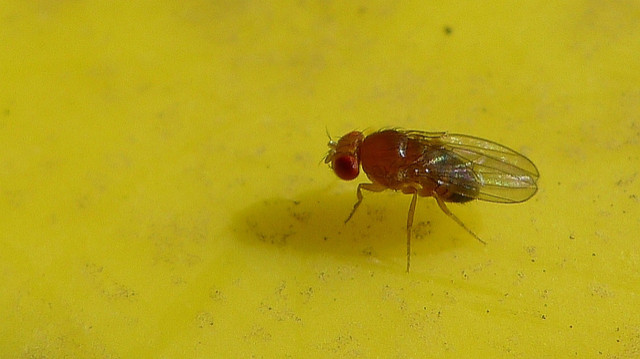Scientists Propose Using Fruit Flies To Study Head Injury

Head injuries can cause a range of problems later in life for veterans, athletes or car accident victims. But the mechanisms behind the long-term effects of a head injury remain something of a medical mystery, partially because it’s hard to find good animal models to simulate them. Now some scientists think that the humble fruit fly can offer a window into the condition.
In traumatic brain injuries or TBIs, some outside force causes a person’s brain to move inside their head and strike the skull. The most common causes of TBI are car crashes, falls, workplace accidents and sports injuries. At first, a person with TBI experiences only mild effects like dizziness, confusion or loss of coordination. But later in life -- and especially if there are multiple traumatic events -- a person who suffers TBI may also suffer memory loss, cognitive problems or dementia reminiscent of Alzheimer’s disease.
But "unlike many important medical problems -- high blood pressure, cancer, diabetes, heart disease -- where we know something about the biology, we know almost nothing about TBI," University of Wisconsin-Madison geneticist Barry Ganetzky said in a statement Monday. "Why does a blow to the head cause epilepsy? Or how does it lead down the road to neurodegeneration? Nobody has answers to those questions -- in part because it's really hard to study in humans."
Ganetzky and colleagues think they’ve found a way to study TBI in fruit flies. While the fly doesn’t have a skull, its brain is housed in a hard layer called a cuticle that’s similar enough, and its nervous system has some similarities to a mammal’s. The researchers describe their first analysis of the model in a paper published on Monday in the Proceedings of the National Academy of Sciences.
The apparatus designed to give fruit flies head injuries consists of a vial attached to a spring, clamped at one end to a wooden board with a polyurethane pad positioned at the other end. The vial is filled with fruit flies; the experimenter bends the spring back, then releases it. The vial snaps forward and strikes the soft pad, enough to rattle the flies around.
“Using the model, we found that fundamental characteristics of human TBI also occur in flies,” the authors wrote.
Similar to a person after a concussion, injured flies temporarily lost motor skills, but gradually recovered. Longer term effects were also evident: flies that received just one strike also had a shortened lifespan compared to flies that didn’t get a rap on the head.
“We also found that primary injuries exacerbate the normal age-related decline in flies,” the authors wrote. “This may explain why human TBI is associated with cognitive and neurodegenerative disorders that are typical of older individuals and why TBI outcomes are worse in older individuals.”
Since fruit flies are widely used in genetic studies, researchers can draw on the wealth of knowledge about various fruit fly strains to figure out both the anatomical and genetic roots of how TBI affects different individuals.
"The heart of the problem of solving traumatic brain injury is that we're all different,” coauthor David Wassarman said in a statement.
SOURCE: Katzenberger et al. “A Drosophila model of closed head traumatic brain injury.” Proceedings of the National Academy of Sciences published online 14 October 2013.
© Copyright IBTimes 2024. All rights reserved.





















